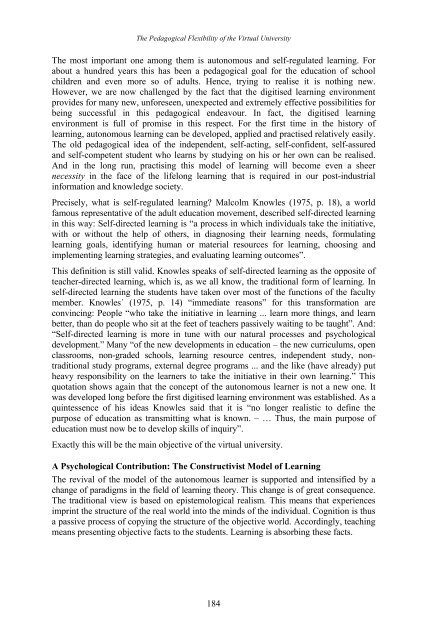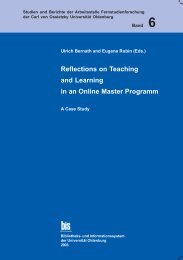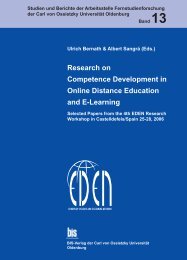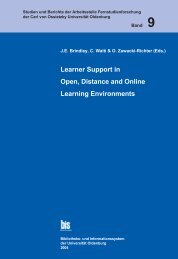Distance Education in Transition - Master of Distance Education ...
Distance Education in Transition - Master of Distance Education ...
Distance Education in Transition - Master of Distance Education ...
Create successful ePaper yourself
Turn your PDF publications into a flip-book with our unique Google optimized e-Paper software.
The Pedagogical Flexibility <strong>of</strong> the Virtual University<br />
The most important one among them is autonomous and self-regulated learn<strong>in</strong>g. For<br />
about a hundred years this has been a pedagogical goal for the education <strong>of</strong> school<br />
children and even more so <strong>of</strong> adults. Hence, try<strong>in</strong>g to realise it is noth<strong>in</strong>g new.<br />
However, we are now challenged by the fact that the digitised learn<strong>in</strong>g environment<br />
provides for many new, unforeseen, unexpected and extremely effective possibilities for<br />
be<strong>in</strong>g successful <strong>in</strong> this pedagogical endeavour. In fact, the digitised learn<strong>in</strong>g<br />
environment is full <strong>of</strong> promise <strong>in</strong> this respect. For the first time <strong>in</strong> the history <strong>of</strong><br />
learn<strong>in</strong>g, autonomous learn<strong>in</strong>g can be developed, applied and practised relatively easily.<br />
The old pedagogical idea <strong>of</strong> the <strong>in</strong>dependent, self-act<strong>in</strong>g, self-confident, self-assured<br />
and self-competent student who learns by study<strong>in</strong>g on his or her own can be realised.<br />
And <strong>in</strong> the long run, practis<strong>in</strong>g this model <strong>of</strong> learn<strong>in</strong>g will become even a sheer<br />
necessity <strong>in</strong> the face <strong>of</strong> the lifelong learn<strong>in</strong>g that is required <strong>in</strong> our post-<strong>in</strong>dustrial<br />
<strong>in</strong>formation and knowledge society.<br />
Precisely, what is self-regulated learn<strong>in</strong>g? Malcolm Knowles (1975, p. 18), a world<br />
famous representative <strong>of</strong> the adult education movement, described self-directed learn<strong>in</strong>g<br />
<strong>in</strong> this way: Self-directed learn<strong>in</strong>g is “a process <strong>in</strong> which <strong>in</strong>dividuals take the <strong>in</strong>itiative,<br />
with or without the help <strong>of</strong> others, <strong>in</strong> diagnos<strong>in</strong>g their learn<strong>in</strong>g needs, formulat<strong>in</strong>g<br />
learn<strong>in</strong>g goals, identify<strong>in</strong>g human or material resources for learn<strong>in</strong>g, choos<strong>in</strong>g and<br />
implement<strong>in</strong>g learn<strong>in</strong>g strategies, and evaluat<strong>in</strong>g learn<strong>in</strong>g outcomes”.<br />
This def<strong>in</strong>ition is still valid. Knowles speaks <strong>of</strong> self-directed learn<strong>in</strong>g as the opposite <strong>of</strong><br />
teacher-directed learn<strong>in</strong>g, which is, as we all know, the traditional form <strong>of</strong> learn<strong>in</strong>g. In<br />
self-directed learn<strong>in</strong>g the students have taken over most <strong>of</strong> the functions <strong>of</strong> the faculty<br />
member. Knowles´ (1975, p. 14) “immediate reasons” for this transformation are<br />
conv<strong>in</strong>c<strong>in</strong>g: People “who take the <strong>in</strong>itiative <strong>in</strong> learn<strong>in</strong>g ... learn more th<strong>in</strong>gs, and learn<br />
better, than do people who sit at the feet <strong>of</strong> teachers passively wait<strong>in</strong>g to be taught”. And:<br />
“Self-directed learn<strong>in</strong>g is more <strong>in</strong> tune with our natural processes and psychological<br />
development.” Many “<strong>of</strong> the new developments <strong>in</strong> education – the new curriculums, open<br />
classrooms, non-graded schools, learn<strong>in</strong>g resource centres, <strong>in</strong>dependent study, nontraditional<br />
study programs, external degree programs ... and the like (have already) put<br />
heavy responsibility on the learners to take the <strong>in</strong>itiative <strong>in</strong> their own learn<strong>in</strong>g.” This<br />
quotation shows aga<strong>in</strong> that the concept <strong>of</strong> the autonomous learner is not a new one. It<br />
was developed long before the first digitised learn<strong>in</strong>g environment was established. As a<br />
qu<strong>in</strong>tessence <strong>of</strong> his ideas Knowles said that it is “no longer realistic to def<strong>in</strong>e the<br />
purpose <strong>of</strong> education as transmitt<strong>in</strong>g what is known. – … Thus, the ma<strong>in</strong> purpose <strong>of</strong><br />
education must now be to develop skills <strong>of</strong> <strong>in</strong>quiry”.<br />
Exactly this will be the ma<strong>in</strong> objective <strong>of</strong> the virtual university.<br />
A Psychological Contribution: The Constructivist Model <strong>of</strong> Learn<strong>in</strong>g<br />
The revival <strong>of</strong> the model <strong>of</strong> the autonomous learner is supported and <strong>in</strong>tensified by a<br />
change <strong>of</strong> paradigms <strong>in</strong> the field <strong>of</strong> learn<strong>in</strong>g theory. This change is <strong>of</strong> great consequence.<br />
The traditional view is based on epistemological realism. This means that experiences<br />
impr<strong>in</strong>t the structure <strong>of</strong> the real world <strong>in</strong>to the m<strong>in</strong>ds <strong>of</strong> the <strong>in</strong>dividual. Cognition is thus<br />
a passive process <strong>of</strong> copy<strong>in</strong>g the structure <strong>of</strong> the objective world. Accord<strong>in</strong>gly, teach<strong>in</strong>g<br />
means present<strong>in</strong>g objective facts to the students. Learn<strong>in</strong>g is absorb<strong>in</strong>g these facts.<br />
184





